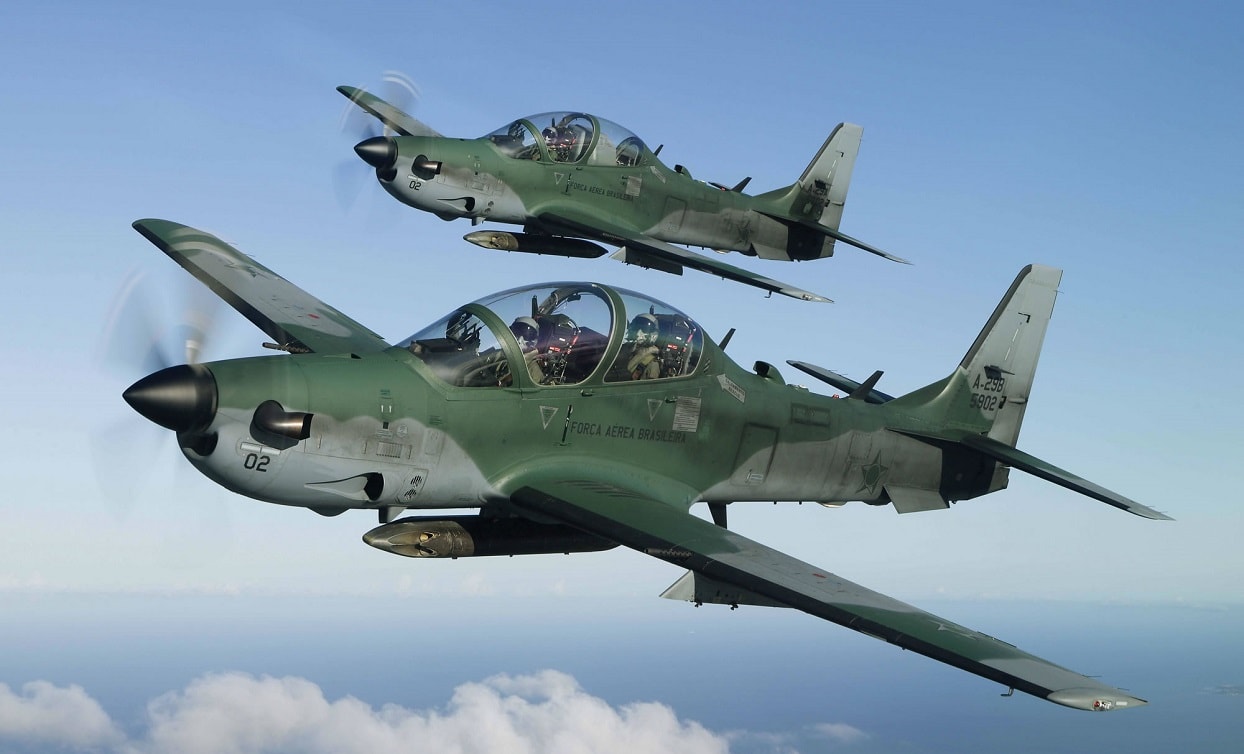Does Russia need a light attack aircraft like the A-29 Super Tucano flown by the U.S. military?
With Islamic militant groups growing in Central Asia – and the Taliban now ruling Afghanistan – the Russian military and its Central Asian client states could use a reliable, relatively inexpensive propeller-driven aircraft like the Super Turcano to fight guerrillas, said Alexander Bartosh in the Russian defense magazine Independent Military Review (English translation here).
“Considering the experience of anti-partisan warfare, the assumed tactics of infiltration of terrorists from Afghanistan to the neighboring territories of Central Asian states, the peculiarities of mountainous terrain in the region, the CSTO [Collective Security Treaty Organization] forces may need inexpensive, relatively slow speed and multipurpose turboprop aircraft capable of carrying various types of weapons,” said Bartosh, a long-time defense commentator and member of Russia’s Academy of Military Sciences.
“Unfortunately, Russia and other CSTO countries do not yet have such machines, and their development and production will take more than a year,” Bartosh added.
As the ideal candidate, Bartosh points to the A-29 Super Tucano, which is becoming a sort of gold standard for light attack aircraft. Derived from the EMB-312 trainer from Brazilian aircraft manufacturer Embraer, the EMB-314 – also known as the A-29 – has a cruising speed of 281 knots, can stay in the air for more than seven hours, and can carry 3,400-pound of missiles and bombs. More than 250 Super Tucanos – some built by U.S. manufacturer Sierra Nevada — are flown by more than a dozen nations, including Colombia, the Philippines and most recently Nigeria (some former Afghan Air Force A-29s were also captured by the Taliban). A contender for the U.S. Air Force’s now-abandoned light attack aircraft program, some A-29s are being used by Air Force Special Operations Command to train foreign pilots.
Naturally, Bartosh isn’t advocating that Russia and its allies buy Super Tucanos. But he recognizes that what nations such as Tajikistan and Uzbekistan isn’t supersonic MiG jet fighters but simple, robust turboprop counterinsurgency aircraft that can fly low, slow and stay in the air for many hours while hunting for insurgents. Not are Moscow’s current plans to rely on helicopters, drones and even Backfire strategic bombers an appropriate solution.
“Given the long borders, rugged terrain, the enemy’s likely use of guerrilla warfare tactics, infiltration of individual terrorist groups and illegal migration, an important role must be assigned to the air component,” Bartosh said. “So far, it is planned to use helicopters and unmanned aerial vehicles in reconnaissance and attack versions for this purpose. Until recently, military experts talked about the possible use of Tu-22M3 long-range bombers in Afghanistan as a ‘long arm’ to attack selected targets in case of enemy attempts to penetrate into Central Asia. For 20 years, the Americans have used strategic aircraft for this purpose in Afghanistan. but the solution proved to be costly and did not make much headway.”
Interestingly, Bartosh believes that Russia once did have its own potential Super Tucano: the T-101 Grach monoplane, designed in the 1ate 1980s as a successor to the An-2 biplane for tasks such as crop dusting. A design like the Grach could be used as a light attack aircraft by Central Asian states as well as exported to global customers.
Also noteworthy is Bartosh’s suggestion that China might team up with Russia to develop a light attack aircraft. “China, which has shown interest in consolidating efforts in Central Asia, could be a partner in the development and production of aircraft designed to operate in the gray zone theaters of hybrid warfare,” said Bartosh.
Bartosh notes that when it to hunting Viet Cong guerrillas in the jungles of South Vietnam, the U.S. learned that the most valuable aircraft were not F-4 Phantom jets, but A-1 Skyraiders that were essentially World War II-era propeller-driven attack planes. Russia may be about to learn the same lesson.
Michael Peck is a defense journalist. He can be found on Twitter and Linkedin.

